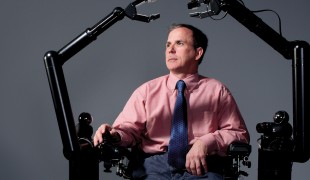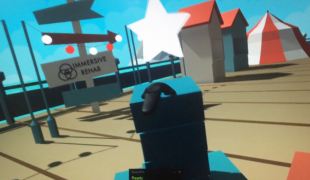- 2993
- 237
- 7
- 13
- 0
- Help Ukraine
About the solution
“I saw the immediate help I could provide to a friend. One of my football teammates, who is also my best friend’s brother, suffered a spinal injury a few years ago and he has been struggling to regain hand function ever since. One of the most memorable experiences, and a major motivation for this project, was when I went to give him a friendly handshake to say hello and all he could do was lift up his hand to offer a fist bump”, said Levy.
Carrying over from research done last summer on tenodesis motion, which uses the flex and extension of the wrist as a mechanism for moving and curling the fingers, Levy wanted to create a device that would help a user to pick up an object that they would not otherwise have the strength to grasp. In an interview with 3DPrint.com, Levy explained the approach to his design:
“Just by watching my wrist move up and down, I noticed that the distance between my forearm and first joint on my finger decreased as I lifted my wrist up. This got me thinking that maybe I could ‘push’ the fingers down with a rod attaching straight from my wrist to my fingers. I made a quick mock up in SolidWorks and printed it out within a few hours (oh the wonders of 3D printing!). After I proved my theory, I dove into the design.”
Levy established three parameters for his design: customizable, comfortable, and low profile.
This type of assistive prosthetic could be extremely helpful to anyone who is suffering from diminished mobility in their hands. Levy envisions those who have suffered from a stroke as being particularly aided by the use of a device such as his. Stroke victims or those who have suffered spinal injuries often heal from their torsos out. In other words, they regain movement in their shoulders first, then elbows, followed by wrists and last in their fingers. Many never recover full use of their fingers and it is exactly this issue that Levy hopes to address with his device, as he says: “there are two main uses for this design. The first is a functional use, where the device will enable a person to grasp an object they otherwise did not have the finger strength to pick up. The second is for at home rehabilitation use, where the person will wear the device and repeat the wrist motion many times over. This repetitive rehabilitation is based on the idea of neuroplasticity, where repetitive assisted motion will generate new connections in the brain and eventually allow the person to move their limbs unassisted.”
Adapted from: http://3dprint.com/83807/spiderhand-mobility-assist/
More info: http://supersam331.github.io/
https://www.youtube.com/watch?time_continue=7&v=LC2RJvZCflE
This solution shall not include mention to the use of drugs, chemicals or biologicals (including food); invasive devices; offensive, commercial or inherently dangerous content. This solution was not medically validated. Proceed with caution! If you have any doubts, please consult with a health professional.
DISCLAIMER: This story was written by someone who is not the author of the solution, therefore please be advised that, although it was written with the utmost respect for the innovation and the innovator, there can be some incorrect statements. If you find any errors please contact the patient Innovation team via info@patient-innovation.com
-
-
266
-
0
-
5051

Paralyzed man designs innovative wheelchairs
CAREGIVING
MOVING IN A WHEELCHAIR: Moving using a wheelchair.
Grip
Rubgy
Basketball
Paralysis
Cervical spinal cord injury/Tetraplegia
Assistive Daily Life Device (to help ADL)
Assistive Technology access
Walking Aid (wheelchair/walker/crutches)
Restoring mobility
Replacing lost limbs
Promoting self-management
Promoting inclusivity and social integration
Recovering from Traumatic Injuries
Preventing (Vaccination, Protection, Falls, Research/Mapping)
Caregiving Support
Neurology
Orthopedics
Physical Medicine and Rehabilitation
United States
-
-
-
251
-
0
-
3143

Helping people affected by neurological conditions live more independent lives again with our digital therapies for neurorehabilitation.
CAREGIVING
(SELF)-CARE: EATING: Eating independently.
(SELF)-CARE: DRINKING: Drinking independently.
(SELF)-CARE: HYGIENE: Maintaining personal hygiene
BODY BALANCE: Maintaining body balance
Multiple Sclerosis
Spinal Cord and Nerve Root Disorders
Stroke
Assistive Technology access
3d Printed
Treatment/Surgical device
Website
Muscle cramps or spasms
Difficulty coordinating movements
Stiffness or rigidity (difficulty moving)
Muscle weakness
Anxiety
Fatigue
Cold hands or feet
Restoring mobility
Rehabilitating After Stroke
Managing Neurological Disorders
Recovering from Traumatic Injuries
To improve Treatment/Therapy
Cardiology
General and Family Medicine
Intensive Care Medicine
Neurology
Physical Medicine and Rehabilitation
United Kingdom
-
-
-
413
-
0
-
7760

Multiple sclerosis patient develops map to help people with disabilities
CAREGIVING
MOVING IN A WHEELCHAIR: Moving using a wheelchair.
WALKING WITH A WALKING AID: Walking with a walking aid
WALKING: Walking
Multiple Sclerosis
Website
App (Including when connected with wearable)
Restoring mobility
Enhancing health literacy
Promoting self-management
Rehabilitating After Stroke
Managing Neurological Disorders
Building Supportive Community Relationships
Promoting inclusivity and social integration
Recovering from Traumatic Injuries
Enhancing Mental Health
Raise awareness
Caregiving Support
General and Family Medicine
Internal Medicine
Neurology
Neurosurgery
Physical Medicine and Rehabilitation
United States
-
 en
en